 |
|
|
As any experienced volunteer with the Half Moon knows, Voyages of Discovery actually begin long before the students step on board. A great deal of preparation goes into any trip aboard a sailing vessel. Although the voyage isn't set to officially begin until the Sunday, September 7th, work has been underway for weeks. We like to acknowledge these prep periods as "Day Zero," the unofficial first "day" of the voyage.
In this case, "Day Zero" actually stretched across a period of weeks and numerous sites up and down the Hudson River.
Caddell Shipyard, Staten Island, NY
Mouse over to operate the dry dock.
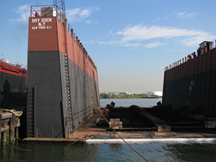 |
In early August, after a period of standard maintenance following the ship's Fresh River Voyage of Discovery, the Half Moon took a special trip down to the floating dry docks of Caddell Shipyard, located on Staten Island, NY.
(Thanks to Bob Hansen for these Caddell Shipyard photographs.)
|
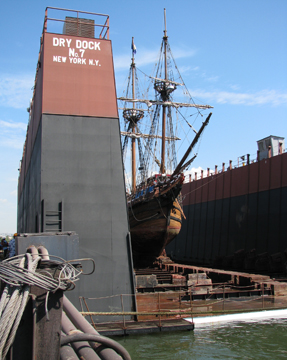
Once at Caddell's the Half Moon was hoisted out of the water so we could inspect and maintain its hull and underwater systems -- a standard procedure that we like to do once every other year or so.
|
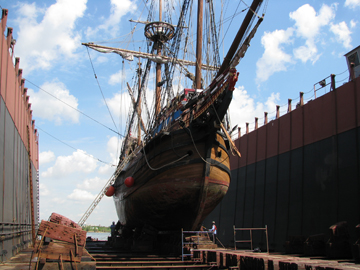
The looming Half Moon is quite an impressive sight when its full size is revealed -- do you see the people working around its keel?
|
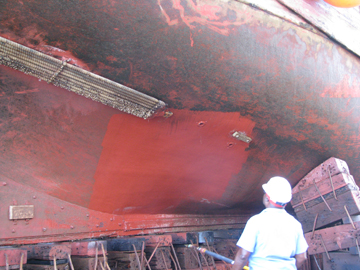
In the two years since the ship's last haul-out at Caddell's the hull had grown thick with slimy algae. Once this was removed with power washers, a new coat of anti-fouling paint was applied.
|
Mouse over to motor away from port.
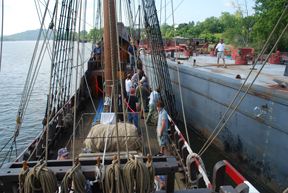 |
Peckham Materials, Athens, NY
After a week of work on Staten Island, the Half Moon returned to its usual haunts at Peckham Materials in Athens Channel. There we returned to our standard maintenance regime.
|
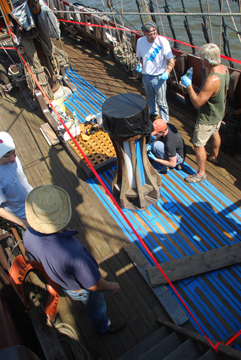
During this phase, one major project among many was routing out and re-tarring the entire weather deck. Here you can see the blue painter's tape used to create clean lines in the seams. Applying the tape and tar (actually just modern caulk, which serves the same purpose) without making a sticky mess by accidentally stepping on what you've already laid down can be quite nervewracking!
While the Half Moon was at Athens, we decided to pull it out of the water one more time before the Voyage of Discovery to make a few final modifications to the ship's rudder and propellor. The tarring job was completed underway.
|
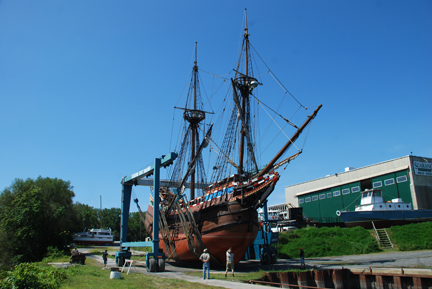
Scarano's Shipyard, Albany, NY
About two weeks before this voyage was due to begin, the Half Moon traveled to Albany, NY, where the operators of Scarano's Shipyard (located at the southern end of the Port of Albany) pulled it out of the river using a rolling power lifter.
The Half Moon is so large that in order to fit in the lift, the mizzen mast (the rearmost mast, not visible here) had to be pulled out with a crane and lain horizontally against the sterncastle. While the mizzen was pulled out, we inspected its base and applied some additional maintenance there as well.
|
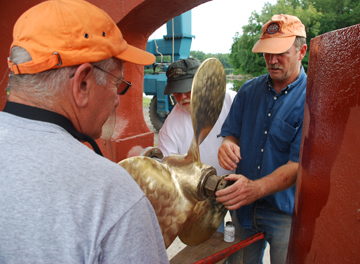
Our main focus, however, was on the ship's propulsion system. The propellor was recalibrated to improve the ship's speed and fuel consumption. (As much as we would like to sail the Half Moon everywhere it goes, modern schedules demand the predictability of an engine.)
|
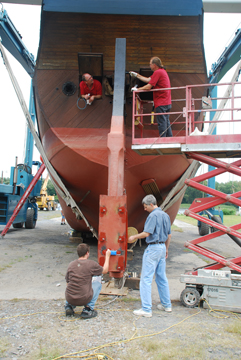
We also added adjustable "wings" to the rudder. Due to the whipstaff design of the ship's steering system (the original Half Moon's construction predates the common use of the ship's wheel by about a century), our rudder as a very limited turning radius -- and thus a more limited steering ability -- than modern vessels.
These wings are intended to improve our steering radius, and this Voyage of Discovery will help determine how well they work.
|
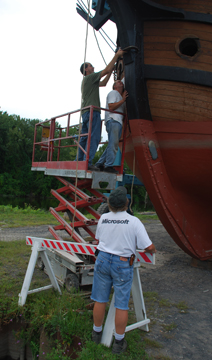
While the Half Moon was hauled out, we purused every opportunity to complete other available maintenance tasks. One major task was to cut and install steel plates along the sides of the keel at the prow of the ship.
|
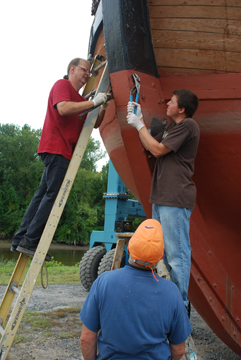
Once bolted into place, these plates reinforce the ship's hull and help prevent wear.
|
Mouse over
to work the line free.
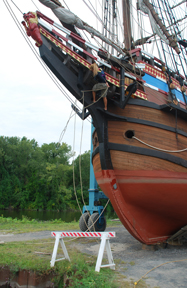 |
The ship's outlegger (a jutting spar that provides leverage to several lines for the fore course) was also removed for repairs.
Climbing out under the beak to remove the lines that had been lashing the outlegger in place is a bit more intimidating without the water under you!
|
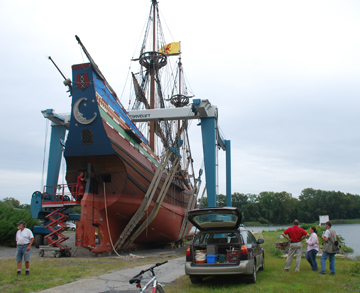
Finally, on August 29th, the Half Moon was ready to return to the river.
|
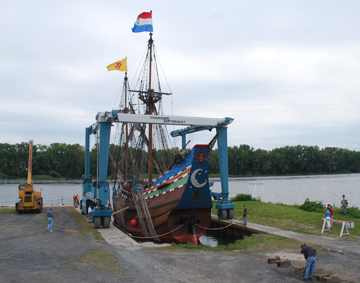
Local media from the Capital Region turned out to document the event as the ship rolled forward and was lowered back into the river.
|
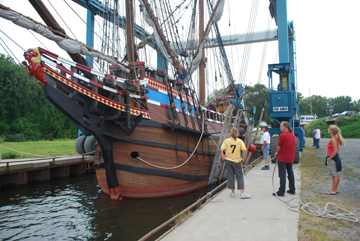
After a quick visual instruction, Captain Reynolds invited one and all to hop aboard for a half-hour shakedown to test the new modifications. All systems go!
In the remaining days before the Voyage, the mizzen mast was lifted back into place.
|
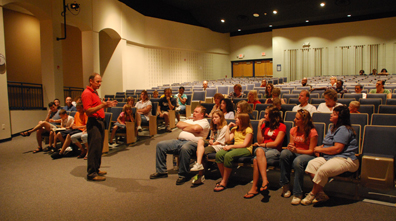
Rensselaer Middle School, Rensselaer, NY
While the ship was being prepared, planning for the voyage itself was well underway. On August 27th, Captain Reynolds and a few student alumnai met with the families of our new student crew to brief them on what to expect. The parents also had a chance to meet the teachers who would accompany their sons and daughters on board.
|
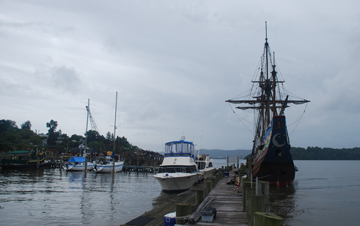
King Marine, Verplanck, NY
Only one task remained: to move the ship into position to accept the crew. On Friday, September 5th, the Half Moon traveled from Albany to Verplanck, NY. A small crew of volunteers worked into the night, arriving at King Marine at roughly 0300 hours -- about 18 hours of total travel time.
|
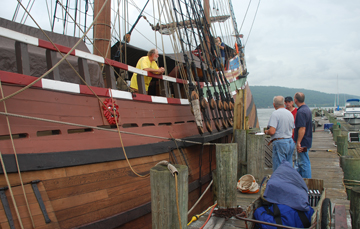
One reason we decided to push onward and reach the dock as soon as possible was the imminent arrival of tropical storm Hanna. On Saturday, September 6th, the crew hustled to finish their tasks and batten down the ship before the driving rains and 40 mph winds could arrive.
|
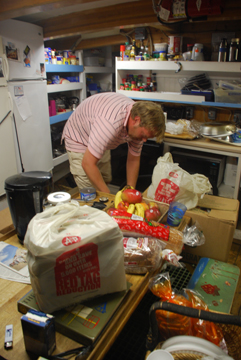 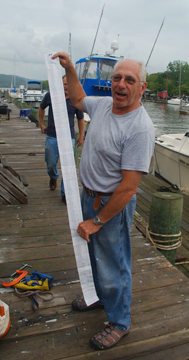
Of course, the singly most vital task to complete was procuring the crew's victuals. Above, Mr. Gorter unloads a portion of the groceries, while volunteer (and frequent ship's engineer) Kipp Van Aken proudly displays his prize catch -- or rather, the receipt for enough groceries to keep two dozen hungry sailors fed for two weeks!
The storm arrived at roughly 1930 hours, and made for a dramatic (if tightly controlled) night, but sorry -- no photos. Stinging downpours and home electronics are not known to play well together!
A special thanks goes out to all of the volunteers who have provided so much of their time and effort on the ship these past weeks in Staten Island, Athens, Albany, Verplanck, and all points in between.
Next: Day One!
|
|
|
|
|
|

